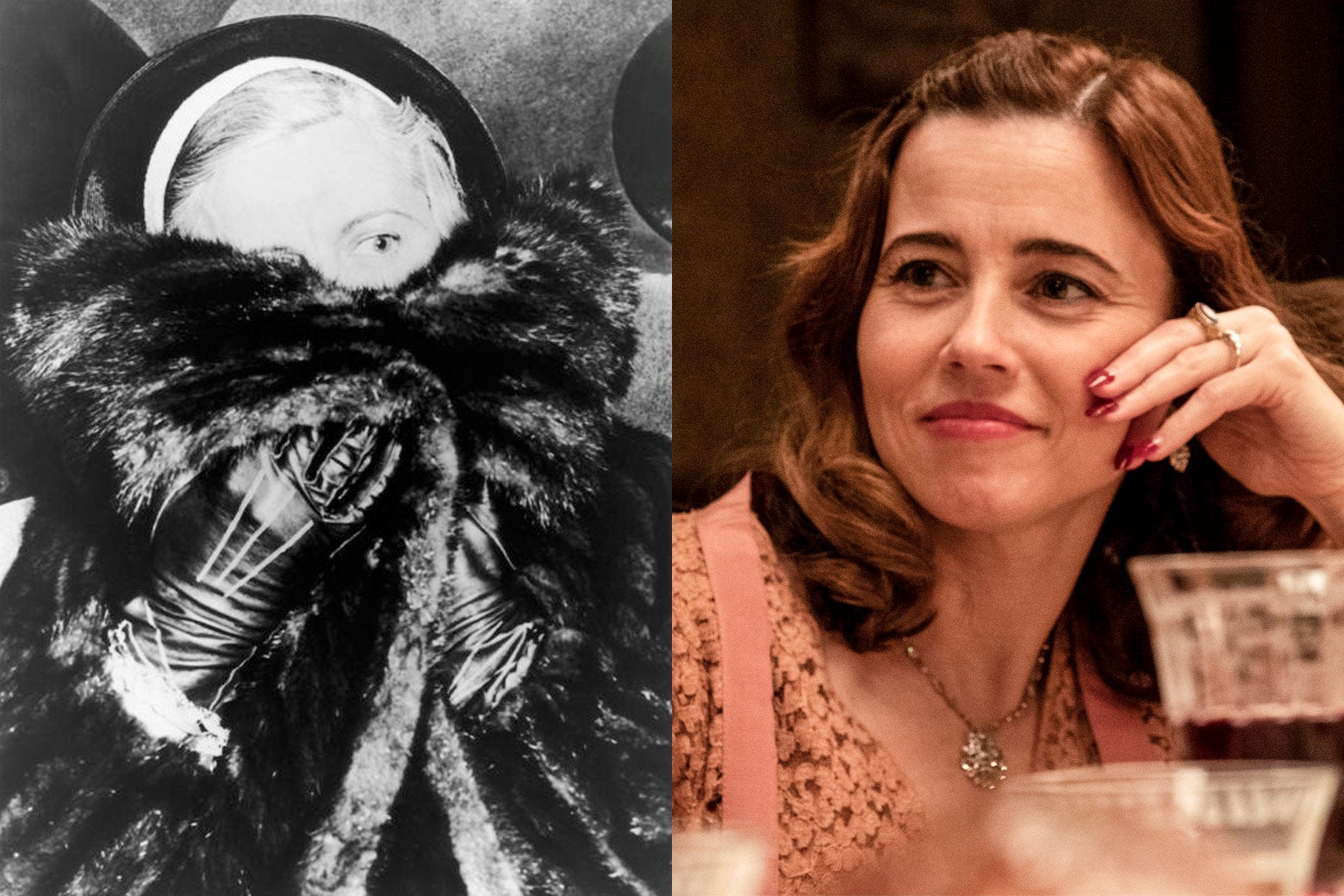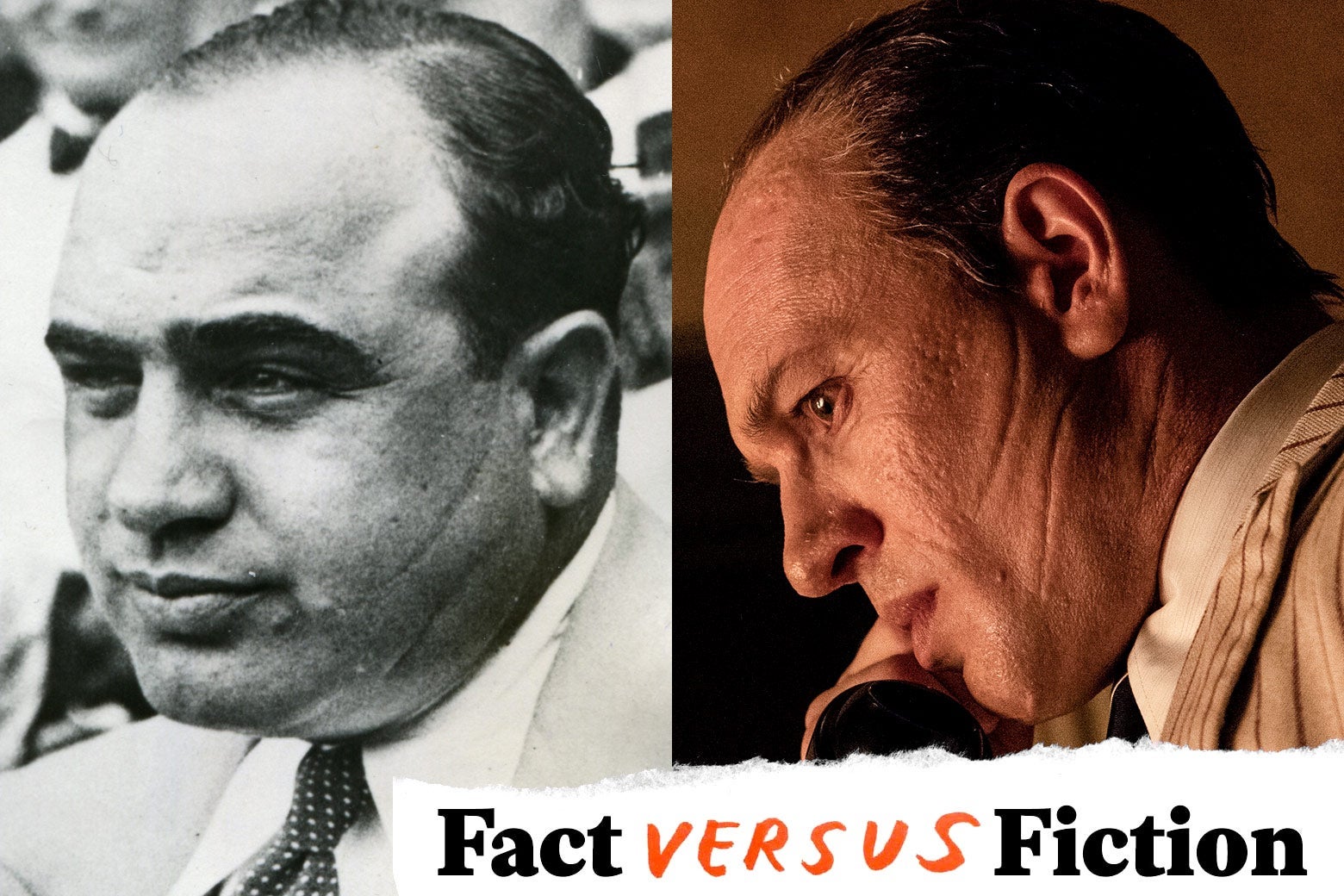Capone, screenwriter and director Josh Trank’s look at the notorious gangster’s final years, out this week on video on demand, is a hallucinatory trip deep into the mind of Al Capone, and an even deeper, even more hallucinatory trip into the mind of Tom Hardy, whose gonzo scene-chewing is the film’s great pleasure. Capone is about guilt and dementia much more than it’s about the Chicago Outfit, but some real people and events from the life of Al Capone make it into the mix. Below, we consult Deirdre Bair’s biography Al Capone: His Life, Legacy, and Legend, contemporary reporting, newsreel footage, and more to break down what’s real, what’s delusion, and what comes only from the demented minds of the filmmakers.
Al Capone (Tom Hardy)
Alphonse Capone was, as you may have heard, a real person, and although many of the events depicted in Capone are imagined, Trank’s vision of his final years has some basis in the truth. Capone led the exceptionally violent organized crime syndicate known as the Chicago Outfit from 1925 until 1931, when he was convicted of income tax evasion and sentenced to 11 years in prison. Diagnosed with syphilis during his intake medical examinations at the federal prison in Atlanta—he probably contracted it as a teenager—Capone was given bismuth therapy, known by then to be worthless. In 1934, he was transferred to the newly opened Alcatraz Federal Prison, where doctors were appalled with the medical care he’d received in Atlanta, but his neurological condition continued to deteriorate. By 1938, the confusion and bad temper caused by the disease had turned into episodes of full-blown delirium, and after he was released from prison in 1939, he went straight to a hospital in Baltimore. From there, Capone retired to a home on Palm Island in Florida he had purchased in 1928. He was eventually treated with penicillin—he was one of the first nonmilitary patients to be given the drug—but it was too late to reverse the damage to his brain. According to biographer Bair, who interviewed Capone’s surviving family members, the family kept him away from strangers, because, according to a Capone family member who did not wish to be identified:
… he said things he should not have. He talked to dead people and told them why they had to die. Sometimes he gave away business. Outfit business. We couldn’t take a chance that any of this would get out.
The FBI surveilled him during this time period, but nothing came of it. Some of the more colorful stories about Capone’s behavior during his last years are dubious—the one about him trying to fish in his swimming pool has been hotly contested by his family—but by 1945 he required constant supervision and was said to have had the mental age of a 7-year-old. He died on Jan. 25, 1947. Here’s some newsreel footage of his Florida estate at the time of his death, including a blimp shot:
Mae Capone (Linda Cardellini)

Mae Capone, née Coughlin, married Al Capone in 1918 and, as seen in Capone, was his primary caregiver during his last years. Mae was the daughter of Irish immigrants—Capone has her conspicuously not understand her husband’s Italian, although it’s hard to tell if that’s the language barrier or the Tom Hardy barrier—and her mother’s opposition to the match meant they were not married until a month after the (premature) birth of their only child, Albert Francis Capone. Mae was not directly involved in her husband’s criminal enterprises; Capone installed his family in a house in the Park Manor neighborhood of Chicago while running his businesses out of a series of hotels. She caught syphilis from her husband but did not suffer the same neurological problems, and reportedly had a difficult time accepting that Al’s mental decline was permanent. She died in 1986.
Besides Al and Mae, and brief appearances from Capone’s brother Ralph (Al Sapienza) and son, Albert (Noel Fisher), the other characters in Capone are composites, fictions, or outright hallucinations. But the film does raise numerous other questions about Al Capone’s life, which we’ll try to answer below.
Did Al Capone Really Sound Like That?
There aren’t any recordings of Capone’s voice, so naturally, Tom Hardy based his on Bugs Bunny. Don’t be fooled: The video below is not newsreel footage of Al Capone.
Did Al Capone Have an Illegitimate Son Who Kept Calling His House in Florida?
Not that anyone knows of. A number of people have claimed to be Capone’s illegitimate offspring, but so far, none of their claims have checked out. Capone was a philanderer and was rumored to have at least one long-term mistress, but so far, there’s no evidence he had children with any of them.
Did Louis Armstrong Sing “Blueberry Hill” at a Party Capone Attended?
During one of Capone’s many hallucinations, he attends an Overlook Hotel–looking party in an art deco ballroom where Louis Armstrong is performing an Overlook Hotel–sounding version of “Blueberry Hill.” As the crowd applauds, Armstrong invites Capone on stage to sing along. This could not have happened: Although “Blueberry Hill” was released in 1940, Armstrong didn’t record his version until 1949, two years after Capone died, and the recordings Capone might have been familiar with don’t sound much like Armstrong’s version, because no one sounds like Armstrong. Here’s Glenn Miller’s take from 1940, with Ray Eberle singing:
But although Capone would have been unlikely to hallucinate Armstrong singing “Blueberry Hill” unless syphilis turned him into a great A&R man, he and Armstrong knew each other, because early in his career, Armstrong played venues Capone’s outfit controlled. Capone ran several clubs in Chicago that catered to mixed-race crowds and had a decent reputation among black musicians for not cheating them. Armstrong later described Capone as “a nice little cute fat boy, young, like some professor who had just come out of college to teach or something.” Fats Waller had a slightly worse experience: He was kidnapped after a performance and taken at gunpoint to play at Capone’s birthday party, which lasted three days.
Was One of Capone’s Mistresses Shot in the Head With a Machine Gun in an Attempt to Hit Capone While He Was Having Sex With Her?
Not that anyone knows. Although there were numerous attempts on Capone’s life, none of them match the killing Capone hallucinates in the film.
Was Al Capone Haunted by the Memory of Witnessing a Former Associate Get Stabbed in the Neck a Comical Number of Times on His Orders?
Maybe? The list of 33 people Capone allegedly ordered killed published in the Chicago Tribune in 1936 doesn’t include anyone who was stabbed. He did have several former associates killed, some for stealing from him, but they were almost all shot. So although the stories of Capone having hallucinatory conversations with people he’d had killed are based on family accounts, the details of the murder Capone hallucinates in Capone seem to be invented.
Did Al Capone Disguise Himself as a Lady to Avoid the Police, Then Go on a Fishing Expedition Where He Killed an Alligator With a Shotgun to Get Revenge After It Stole His Fish?
Probably not! He loved fishing, and according to Bair, his mental condition caused him to fixate on an upcoming fishing trip to Wisconsin in 1941 with “the joy of a boy being told he was about to get the treat of his dreams.” As late as 1945, he was still taking fishing trips on his boat, the Sonny & Ralphie, but his condition was such that he wasn’t allowed to go alone.
OK, but Did Al Capone Hallucinate Disguising Himself as a Lady to Avoid the Police, Then Hallucinate Going on a Fishing Expedition Where He Hallucinated Killing an Alligator With a Shotgun?
Uh, sure.
Did a Diaper-Clad Al Capone Shoot Up His Own House With a Gold-Plated Tommy Gun, Murdering Countless Servants and Henchmen?
Nope. That’d be hard to keep out of the papers! His dementia meant he was prone to violet tantrums, and at one point soon after his release from prison, he attacked his brother John with “physical violence,” but he didn’t commit any mass shootings.
But He Totally Wore Diapers, Though, Right?
Incontinence can be a symptom of late-stage neurosyphilis, but the historical record is inconclusive.
Did Al Capone Really Hide $10 Million and Then Forget Where He Hid It?
Rumors of hidden Capone treasure were around long before Geraldo opened his vault. But there is no evidence that the FBI or Capone himself ever believed this.
Are You Sure You Don’t Remember Where Al Capone Hid His Money?
Remember? What are you talking about?
Where’s the Money, Al? Where Did You Hide the Fuckin’ Money?
I don’t remember! I can’t remember! Ma, chi ti ha mandato? Chi cazzo sei?
Oh, So You’re Gonna Play It That Way, Are You?
Louis Armstrong? You? Here? How?
Stab! Stab stab stab stab stab! Stab stab, stab stab stab stab, stab. STAB!
Oh, you better believe I’m going to haunt you for this.
